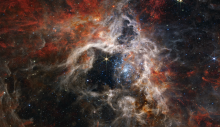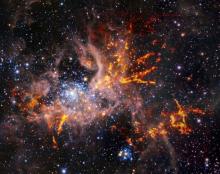Listen to today's episode of StarDate on the web the same day it airs in high-quality streaming audio without any extra ads or announcements. Choose a $8 one-month pass, or listen every day for a year for just $30.
You are here
Magnetic Bursts
One of the big astronomical mysteries of the last decade or so has been the origin of fast radio bursts. In recent months, though, astronomers have found that at least some of them may be powered by magnetars — the super-magnetized remnants of exploded stars.
A fast radio burst lasts about a thousandth of a second. In that instant, though, it emits more energy than the Sun produces in several days. But most bursts are in other galaxies, so they’re hard to study.
Last April, though, a burst was recorded inside our home galaxy, the Milky Way. It came from a known magnetar.
A magnetar is the ultra-dense corpse of a star that exploded as a supernova. It’s heavier than the Sun, but only a few miles across. And it has a magnetic field that can be a trillion times as powerful as Earth’s.
Starting on April 27th, X-ray telescopes in space saw the magnetar produce a series of outbursts. After a few hours, it produced an especially powerful burst — a fast radio burst.
Astronomers aren’t sure just how a magnetar produces such an event. One study says it may begin with a “quake” — a crack in the magnetar’s crust. That shoots out a magnetic bubble that disrupts the surrounding magnetic field. The field reconnects behind the bubble, triggering a short but powerful burst of energy.
There could be more than one way to make fast radio bursts. But last April’s event suggests that at least some of them could come from super-magnetic stars.
Script by Damond Benningfield





